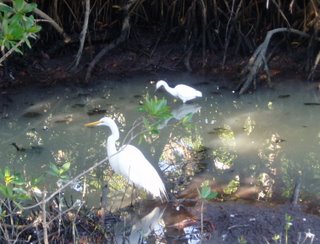 Wednesday, December 27, 2006--After lunch, we stopped at the visitor center for the Ding Darling National Wildlife Refuge, which takes up half of the acreage of Sanibel Island. This refuge is part of the system of refuges located along migration routes, and it has both year-round and winter visitors. Like everything else we have seen in Florida, it is more water than land. Large lakes, inlets, bayous and canals provide all kinds of habitat for winged and other creatures. We took pictures mostly of birds, but we also saw some mischievous raccoons, several skinks (small lizards) and (maybe) an alligator.
Wednesday, December 27, 2006--After lunch, we stopped at the visitor center for the Ding Darling National Wildlife Refuge, which takes up half of the acreage of Sanibel Island. This refuge is part of the system of refuges located along migration routes, and it has both year-round and winter visitors. Like everything else we have seen in Florida, it is more water than land. Large lakes, inlets, bayous and canals provide all kinds of habitat for winged and other creatures. We took pictures mostly of birds, but we also saw some mischievous raccoons, several skinks (small lizards) and (maybe) an alligator. Egrets are a staple of shallow ponds and ditches all over the Ft. Myers area, but at the refuge we saw both the Great Egret (foreground) and the Snowy Egret, which is smaller and has a black bill and bright yellow legs and feet, although you can't tell that from this picture, since the bird is wading in the murky water. How they found fish to catch, only they know.
Egrets are a staple of shallow ponds and ditches all over the Ft. Myers area, but at the refuge we saw both the Great Egret (foreground) and the Snowy Egret, which is smaller and has a black bill and bright yellow legs and feet, although you can't tell that from this picture, since the bird is wading in the murky water. How they found fish to catch, only they know. As one drives through the refuge on a one-way road, people frequently pull over to see various birds that have been sighted. At right is a female Anhinga, sunning itself on a tangle of mangrove roots. These very long-necked birds swim under water to catch fish, then climb out to spread their wings, preen and dry off before going fishing again. Later we saw a male anhinga, which is black all over, with white stripes on its wings.
As one drives through the refuge on a one-way road, people frequently pull over to see various birds that have been sighted. At right is a female Anhinga, sunning itself on a tangle of mangrove roots. These very long-necked birds swim under water to catch fish, then climb out to spread their wings, preen and dry off before going fishing again. Later we saw a male anhinga, which is black all over, with white stripes on its wings. Not far from the Anhinga, we spotted this large white bird sunning itself as well. A tram full of sightseers drove by without ever realizing that we were looking at an endangered species, a Wood Stork. It had its beak tucked in its neck feathers and was hard to identify until I noted in the field guide that this bird has bubble-gum pink feet. Unfortunately, the resolution on the photo isn't good enough to show that, but they were Pink. I swear.
Not far from the Anhinga, we spotted this large white bird sunning itself as well. A tram full of sightseers drove by without ever realizing that we were looking at an endangered species, a Wood Stork. It had its beak tucked in its neck feathers and was hard to identify until I noted in the field guide that this bird has bubble-gum pink feet. Unfortunately, the resolution on the photo isn't good enough to show that, but they were Pink. I swear. This Yellow-Crowned Night Heron was one of several birds stalking in a large bay off the road to the left of our car. During this drive we also saw a flock of Roseate Spoonbills, several Little Blue Herons, Great Blue Herons, Gulls, White Ibis, various Sandpipers, Brown Pelicans and White Pelicans.
This Yellow-Crowned Night Heron was one of several birds stalking in a large bay off the road to the left of our car. During this drive we also saw a flock of Roseate Spoonbills, several Little Blue Herons, Great Blue Herons, Gulls, White Ibis, various Sandpipers, Brown Pelicans and White Pelicans. Ubiquitous throughout the refuge, as well as the beach and even in domestic plantings on the island and in Ft. Myers is a wiry, woody, viny plant called the Sea Grape. A guide to the beach noted that it is planted to curtail beach erosion. It seems to be doing its job!
Ubiquitous throughout the refuge, as well as the beach and even in domestic plantings on the island and in Ft. Myers is a wiry, woody, viny plant called the Sea Grape. A guide to the beach noted that it is planted to curtail beach erosion. It seems to be doing its job!Our Sanibel trip was a wonderful experience of nature and shore, and we saw and talked with interesting people at both the island visitor center and the nature preserve. Our trip became more of an adventure as we tried to get back to Ft. Myers. We ran over some kind of object that embedded itself in our left front tire, but with luck we found an open filling station where a young man pulled and plugged it and made it good as new. We also spent one hour going five miles in the legendary island traffic, but even that was not enough to spoil memories of lighthouses, beaches, shelling, and marvelous wildlife.








1 comment:
It sure looks like Doug and Matt are in a beautiful spot.
I'm enjoying your blog.
Post a Comment